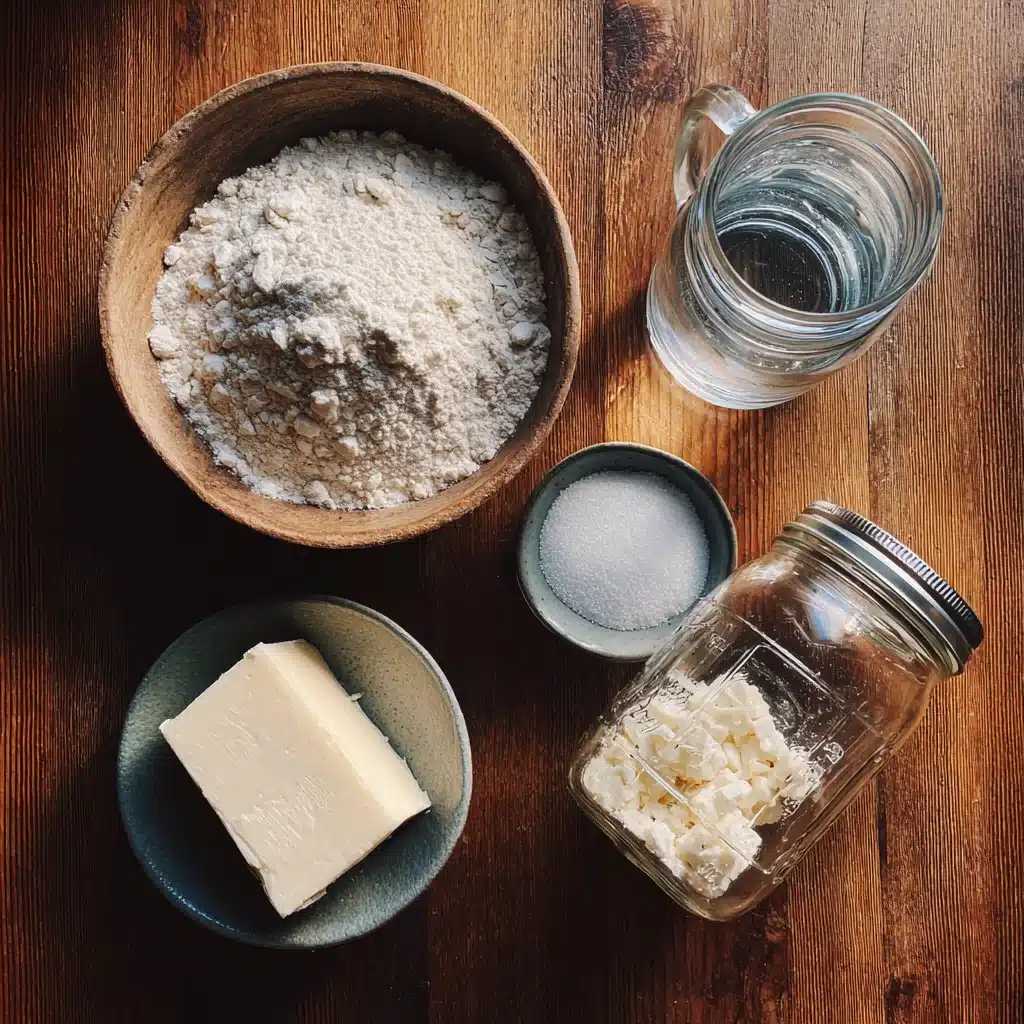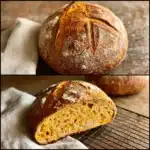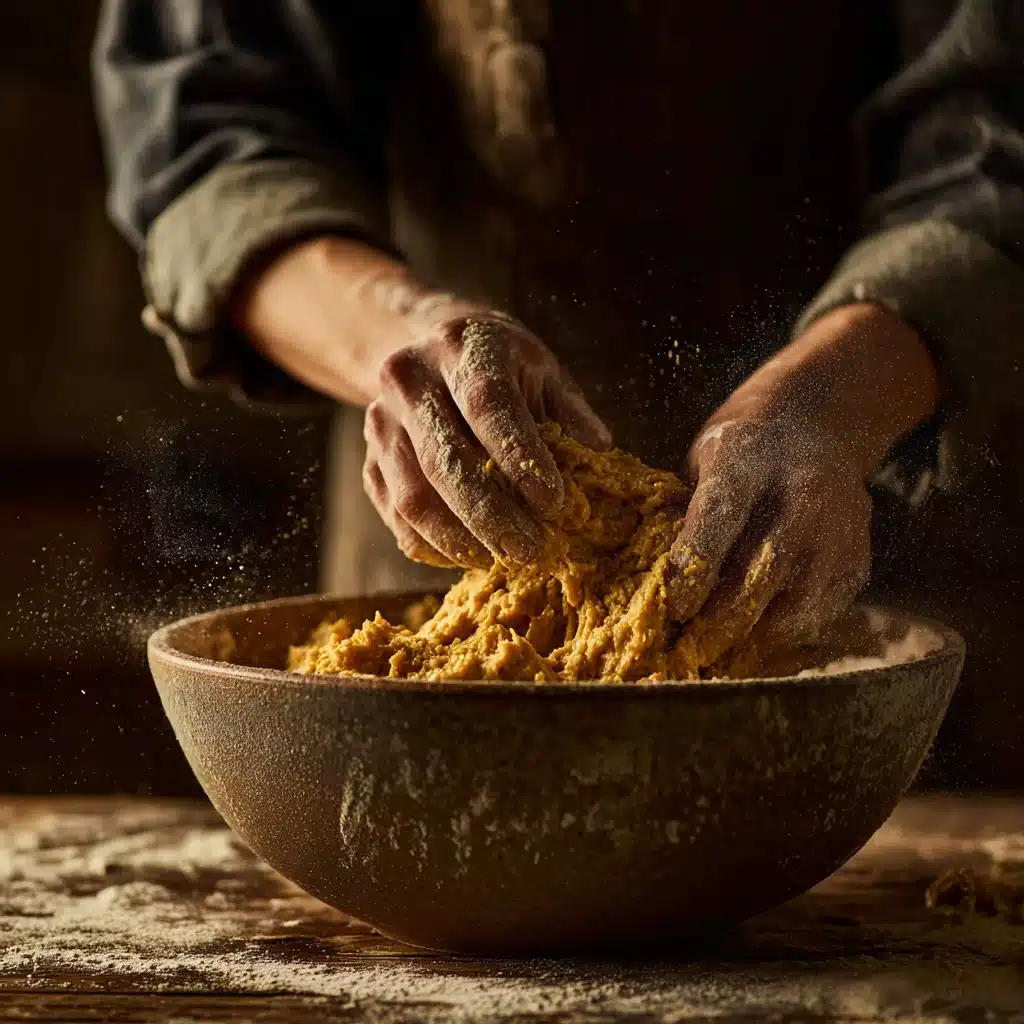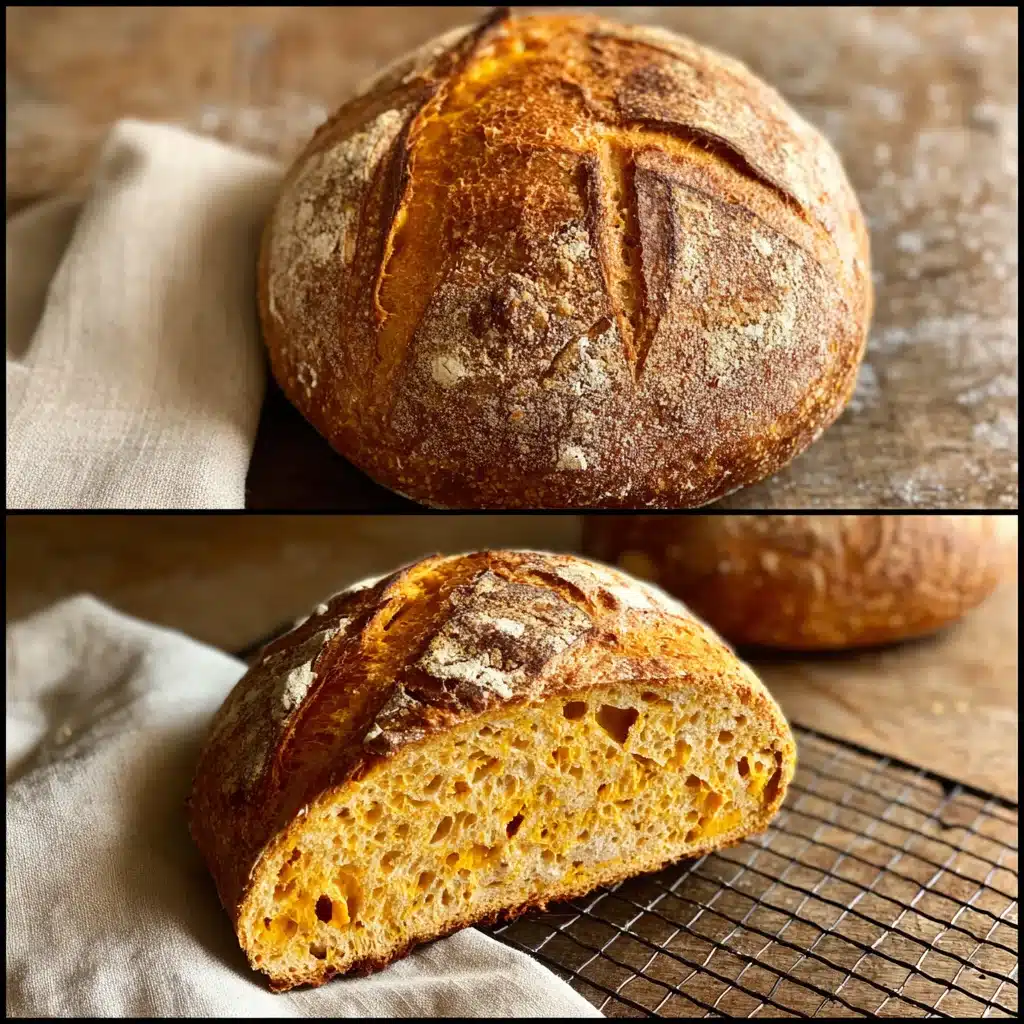Crisp mornings in Mendocino make me reach for something warm and golden, and pumpkin sourdough bread does the trick every time. It’s soft, subtly tangy, and gets just the right hint of earthiness from real pumpkin. Whether you’re craving a toast that tastes like fall or experimenting with seasonal bakes, this loaf brings comfort in every bite. In this guide, I’ll show you how to incorporate pumpkin into your sourdough, avoid common pitfalls, and even add spice or seeds if you’re feeling bold. Grab your starter, and let’s turn cozy into crusty and delicious.
The Story Behind This Pumpkin Sourdough Bread
A Cozy Fall Loaf With a Tangy Twist
Let me tell you, this loaf was born on a rainy October morning when Clementine (that’s my starter) was bubbling away on the counter, and my son asked if sourdough could taste like pumpkin pie. I laughed, but then I grabbed the leftover purée from the fridge, folded it into my dough, and something magical happened.
The pumpkin doesn’t just color the crumb; it adds softness and a hint of earthy sweetness that balances sourdough’s natural tang. It’s like autumn in every slice. I’ve played around with sourdough discard pumpkin bread recipes too, but this one, using an active starter, creates that gorgeous oven spring and tender, golden crumb that I love sharing at our bakery’s Sunday brunch table.
Why This Pumpkin Sourdough Bread Works So Well
Pumpkin puree increases the dough’s hydration slightly, but it also enriches the flavor, giving the bread a subtle, warm tone without overpowering the sourdough profile. Combined with just a touch of raw honey, the bread has depth without being sweet.
Even better, this bread toasts beautifully. You can smear it with cream cheese, serve it with butternut soup, or go wild and turn it into French toast. And if you’re wondering about incorporating pumpkin spice, absolutely. This recipe works beautifully as a pumpkin spice sourdough bread, too, with just a pinch of cinnamon, ginger, and nutmeg.
I’ll also link in recipes for spiced sourdough rolls and tips on maintaining starter consistency from Quick USA Recipe so you can experiment confidently.


Pumpkin Sourdough Bread – 5 Surprising Reasons It’s Better
- Total Time: 18 hours
- Yield: 1 loaf 1x
- Diet: Vegetarian
Description
This cozy, naturally leavened pumpkin sourdough bread brings together the tang of wild yeast with the subtle sweetness of real pumpkin puree. It’s perfect for fall mornings, hearty sandwiches, or toasting with a pat of butter.
Ingredients
100 g Sourdough Starter (fed and bubbly)
200 g Pumpkin Puree (homemade or canned)
500 g Bread Flour
280 g Water (adjust as needed)
20 g Raw, unprocessed honey
10 g Salt
Instructions
1. In a large bowl, mix starter, pumpkin puree, and water until combined.
2. Add flour and mix into a shaggy dough. Let rest for 30 minutes.
3. Add salt and honey. Mix well by hand or spoon.
4. Cover and perform 3–4 rounds of stretch and folds every 30 minutes.
5. Let dough rise at room temperature until doubled (4–6 hours).
6. Shape into a round or batard and place in floured proofing basket.
7. Cover and cold proof overnight in the fridge (8–12 hours).
8. Preheat oven to 475°F with Dutch oven inside.
9. Score loaf, transfer to hot Dutch oven, and bake covered 20 minutes.
10. Uncover and bake another 20–25 minutes until golden brown.
11. Cool completely before slicing.
Notes
Optional: Fold in 40–50g toasted pumpkin seeds during last stretch and fold.
To make pumpkin spice sourdough, add 1 tsp cinnamon, ¼ tsp nutmeg, and ¼ tsp ginger to dry ingredients.
This bread freezes well—wrap tightly and store up to 1 month.
- Prep Time: 20 minutes
- Cook Time: 45 minutes
- Category: Bread
- Method: Baking
- Cuisine: American
Nutrition
- Serving Size: 1 slice
- Calories: 160
- Sugar: 1g
- Sodium: 290mg
- Fat: 1g
- Saturated Fat: 0g
- Unsaturated Fat: 1g
- Trans Fat: 0g
- Carbohydrates: 33g
- Fiber: 2g
- Protein: 5g
- Cholesterol: 0mg
Keywords: pumpkin sourdough bread, sourdough discard pumpkin bread, pumpkin spice sourdough bread
Mastering the Pumpkin Sourdough Bread Process
Mixing Pumpkin Into Sourdough: The Right Way
Pumpkin sourdough bread begins with a well-fed, active starter, 100 grams of it, bubbly and ready to work. To this, add 200 grams of smooth pumpkin puree. Homemade or canned both work well, but avoid anything spiced or pre-sweetened. Pumpkin doesn’t just tint your crumb a warm gold, it adds richness and a soft, silky texture that keeps the loaf moist for days.
Hydration is crucial here. Pumpkin already contains water, so start with 280 grams and adjust as you go. Once mixed, your dough will feel a bit softer than standard sourdough. That’s perfectly normal. Add 10 grams of salt and 20 grams of raw honey to balance the tang with a touch of earthiness. Honey also adds natural sugars that help with caramelization during baking.
I’ve compared this process with other enriched sourdoughs like my rosemary olive sourdough, and pumpkin-based dough is one of the most forgiving. It’s pliable, easy to stretch and fold, and develops strength without aggressive kneading.
Let it rest for 30 minutes after mixing. Then, perform three to four rounds of stretch-and-folds over two hours. This develops the gluten gently and prepares your dough for shaping.
Shaping, Proofing, and Baking Pumpkin Sourdough
After bulk fermentation (about 4–6 hours), shape the dough into a round or batard. You can flour a proofing basket or line a bowl with a floured towel. Then, refrigerate overnight for cold proofing, this improves the crust and flavor, especially for pumpkin sourdough bread.
When baking, preheat your oven and Dutch oven to 475°F. Bake covered for 20 minutes to trap steam, then uncovered for another 25. The result is a loaf with a golden crust and a tender, open crumb that smells like warm comfort.
If you’ve ever tried making a sourdough discard pumpkin bread, you’ll notice the flavor here is deeper and the texture chewier thanks to the wild yeast. The fermentation also makes the loaf easier to digest.
Want more ideas? You can explore our no-knead sourdough guide if you prefer a more hands-off approach. Or dive into this method with our basic sourdough timeline to plan your bake with precision.
This is the kind of loaf I make on cool Saturday mornings, when the fog rolls off the ocean and the scent of cinnamon coffee fills my kitchen. Trust me, it’s worth the wait.

Toppings, Seeds, and Variations for Your Pumpkin Sourdough Bread
Can You Put Pumpkin Seeds in Sourdough Bread?
Absolutely. Pumpkin seeds bring crunch, visual appeal, and a slight nuttiness that contrasts beautifully with the soft crumb of pumpkin sourdough bread. I like to add them in two ways: some mixed into the dough during the last stretch and fold, and the rest sprinkled on top after shaping.
If you’re mixing them in, use about 50 grams of raw, unsalted pumpkin seeds. Lightly toast them first to deepen the flavor and reduce moisture. Fold them in gently to avoid tearing your gluten structure.
For topping, mist your dough with water after shaping, then roll the top in a shallow dish of pumpkin seeds. This helps them stick during the final proof and gives your baked loaf a golden, rustic finish. I’ve done the same thing for our seeded sourdough crackers, and it works every time.
Bonus tip: You can also mix in sunflower seeds, chia, or even chopped pecans if you’re aiming for something heartier, like our whole grain walnut sourdough.
Flavor Twists for Pumpkin Spice Sourdough Bread
If you want this to lean toward dessert, the spice route is your friend. Try adding:
- 1 tsp cinnamon
- ¼ tsp nutmeg
- ¼ tsp ground ginger
- Optional: a pinch of clove or allspice
Add these to the dry flour before mixing, so the flavors distribute evenly. The result? A perfectly balanced pumpkin spice sourdough bread that tastes like fall without turning into cake.
Want to go sweeter? Swirl in a little maple syrup or brown sugar and raisins. Or use this same dough to shape into mini rolls, just like we do for our spiced sourdough pumpkin buns during bakery bake-alongs.
Pumpkin sourdough bread is endlessly flexible, you can go savory (add sage, roasted garlic) or sweet (add vanilla, chopped dates, or cranberries). Think of this loaf as a canvas for all your favorite fall flavors. And remember, even the seasoned bakers in my workshops are still surprised by how this one becomes a crowd favorite.
What Not to Do with Sourdough + Why It’s Better for You
Sourdough Slip-Ups to Avoid (Yes, Even With Pumpkin)
Let’s be honest, baking sourdough isn’t just about flour and water. It’s about timing, intuition, and learning from failure. And pumpkin sourdough bread comes with a few curveballs that even seasoned bakers can miss.
Don’t ignore your starter
If your starter isn’t fed and bubbly, your dough won’t rise. For this recipe, make sure it’s been fed within 4–6 hours and is doubling in size. Using discard instead? That’s perfect for quick bakes like sourdough discard pumpkin muffins, but not for a proper loaf.
Don’t treat pumpkin like water
Pumpkin puree brings moisture, but not like plain water. It thickens the dough, affects gluten development, and changes fermentation timing. Start with less water than you would for basic sourdough and adjust gradually.
Don’t overproof
Pumpkin adds natural sugars that feed the yeast quickly. If your dough is rising faster than expected, it’s probably the pumpkin doing its thing. Watch for volume and texture, not the clock. Overproofing leads to a flat, sour loaf.
Don’t skip the cold proof
That overnight chill in the fridge isn’t just for convenience, it gives your loaf a sharper flavor and helps you score it cleanly before baking. This is especially helpful when working with enriched doughs like pumpkin sourdough bread or our honey whole wheat sourdough.
Why Pumpkin Sourdough Bread Is Actually Good for You
Here’s the part your gut will thank you for: sourdough is naturally fermented, making it easier to digest than regular bread. During the fermentation, lactic acid bacteria break down phytic acid and begin breaking gluten into simpler forms. The result? A loaf that’s gentler on the stomach and lower on the glycemic index.
Now add pumpkin. Suddenly your humble slice becomes a source of beta carotene, potassium, and fiber. You get flavor and nourishment, a rare combo in most breads. It’s why I love baking with ingredients like pumpkin and whole grains in my bakery’s gut-friendly bread line.
This loaf proves that indulgent and wholesome aren’t opposites. They can live side by side, warm from the oven, waiting for butter and good company.

Conclusion
Pumpkin sourdough bread is more than just a fall recipe, it’s a celebration of everything warm, cozy, and nourishing. With its soft crumb, tangy edge, and just a whisper of sweetness, this bread brings seasonal joy to any table.
Whether you’re baking it to share with family, impress a guest, or just to enjoy with your morning coffee, it’s a loaf that teaches patience, rewards curiosity, and welcomes your creative twists.
From my kitchen in foggy Mendocino to yours, may your crust crackle, your crumb shine, and your heart feel full.
Frequently Asked Questions
Can you add pumpkin to sourdough?
Absolutely. Pumpkin adds moisture, flavor, and softness to your sourdough. It also introduces natural sugars, which slightly speed up fermentation. Just be sure to adjust your hydration and watch your proofing time.
Why is sourdough bread so much better for you?
Sourdough’s long fermentation process breaks down gluten and phytic acid, making the bread easier to digest and more nutritious. It’s often better tolerated by people with mild gluten sensitivity and has a lower glycemic impact than commercial bread.
Can you put pumpkin seeds in sourdough bread?
Yes! Pumpkin seeds add a nutty crunch and make a beautiful crust topping. Mix some into the dough or roll the shaped loaf in seeds before baking. Toast them first for deeper flavor.
What not to do with sourdough?
Don’t use an unfed starter, skip bulk fermentation, or overproof your dough. Avoid adding mix-ins too late or skipping cold proofing, both impact texture and flavor. For pumpkin sourdough bread, never treat the puree like water, it changes how the dough behaves.

